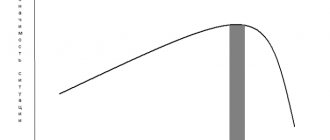In one collection of logic problems, readers were presented with the following task: “An archaeologist found a coin on which it was indicated that it was made in 7 BC. e. But his colleagues immediately told him that it was a fake. How did they determine this? The author himself said at the end of the book that he received letters with very different and, at times, strange answers. Some have speculated about the designs on the coins, some about the metal, others about the location where the coin was found. But in fact, the answer turned out to be much simpler - the inscription on the coin “BC.” e." could only have been made during our era, therefore the coin was a fake.
Why did such an obvious answer cause so many people difficulty? This approach to problem solving, which is based on previous experience or already known methods of action, is called rigidity or inertia of thinking.
Inertia in children
Inertness or slowness of mind, another synonym for inertia of thinking, is not always found exclusively in clinical cases. You can try for a long time to explain to your child that a whale is an animal, but using the experience he has already gained, he will insist that it is a fish and will not accept your words. You should not lose your temper; it is quite possible that the reason is not stubbornness, his behavior is characterized by inertia of thinking.
It is quite difficult for children to get used to new rules, to cope with volumes of information, and then they begin to act according to already established rules, ignoring the changed conditions.
Flexibility of thinking vs rigidity
Most conflicts in relationships are explained by rigid thinking, but people prefer other explanations **Knockout Survivor
Flexibility of thinking helps to avoid aggressive confrontation. Compliance and diplomacy in a controversial situation - evidence of flexibility - can set opponents in a peaceful mood.
How do you explain this dark term “inertia of thinking”? As for me, friends, this is a fixed and petrified mind, unable to move forward. She is the primary enemy of knowledge and life changes.
Inert thinking is atrophied, stagnant, conservative, it falls into a stupor when it is necessary to make a new decision. Everything new and unknown causes fear in inertia.
The confrontation between rigidity and flexibility in thinking has been going on for more than one millennium. Let us only remember the eighteenth century, when a doctor who prescribed quinine for fever was threatened with deprivation of his diploma. And the Parisian Faculty of Medicine characterized smallpox vaccination as “frivolity,” “a crime,” and even “a means of magic.”
An inert person drowns in the routine of life, enjoying the absence of change. The trouble with inertia is the lack of a sense of proportion in one’s attachment to reflexive habits, individual objects and situations. Ignoring the fundamental principles, not knowing the limits of her preference, she is simply lost in the multifaceted world.
Whether we like it or not, the basis of our life is change. Even the entire human body at the cellular level is renewed many times during its life activity. And sometimes such an update brings discomfort. Tell me, friends, will a wise person resist such a renewal?
Everyone wants change, but everyone is afraid that something might happen **Vitebsk Stork
Why do we get angry and shout? Most often due to fear. We are afraid that we will have to change ourselves, our established beliefs and habits. After all, then the fallacy of the entire life path that has already been passed may be revealed. We are afraid of someone else's reproach for our inadequacy.
If unexpected changes burst into our lives without knocking, we just need to admit the truth that is not comfortable for us. But sometimes we sit in the “trenches” of life until the “tank” of change begins to iron us. And we sit until the last moment, when the second wind is already running out, and there is still no help in sight.
Suppose we puncture a tire on a highway. What do we do? Change the wheel. Really change it? Is it really a change?
What if the old limiting attitudes have failed, what if the current level of consciousness has “punctured” and forces us to turn on the emergency lights and drive off the road?
To those who do not carry out reforms, the Reformation will come knocking **S. Jerzy Lec
How to overcome
When it comes to the clinical cases described in the first part of this article, treatment should be handled exclusively by a doctor. This is a requirement. If you decide on your own that you have some problems finding answers and you want to develop your own intelligence and instill in yourself new qualities, then the best way would be logic problems.
Over time, chess, backgammon, monopoly and other board games will help raise your level of intelligence and teach you to quickly find the right solutions. Solve crosswords, Sudoku, buy other games to develop logic that you can play yourself. Psychology has not yet come up with a more effective way to eliminate this problem.
Also, don't forget to read. It engages imagination, develops memory, and contributes to the emergence of new everyday experiences. I can also recommend you several books to develop your creative abilities.
Flexibility of thinking. What are we talking about
Try to raise your son competently and you will understand that this requires greater flexibility of thinking than governing the state **From what was unspoken by Maria
Let's start with definitions again, friends.
Flexibility of thinking is defined as a person’s ability to quickly and easily find new solution strategies. This is a kind of ability to freely manage the source material, establish associative connections and see the situation as it develops: break it down into components, redistribute it.
It implies a willingness to look at a problem from a different angle and be able to predict possible outcomes of a particular decision. This way of thinking promotes multi-level cognition and comprehensive understanding, an excellent basis for a positive attitude.
To make it clearer what flexibility of thinking is, I will give an example of the opposite concept: mental rigidity and inertia.
Slowness and slowness of thought processes, clearly expressed in stiffness and difficulty when switching from one type of activity to another. Clumsiness and inertia of thought prevent people from competently and rationally correlating general rules and exceptions to them.
It's no secret that 80% of everything we do on weekdays is determined by our habits. Therefore, it is sometimes difficult for us to calmly react to what arises outside the boundaries of our habits. We are surprised, indignant, irritated, angry, even attacking aggression.
Someone, when new ideas, people, methods, approaches appear from outside, takes a “quiet” position. This is how xenophobia and similar illnesses arise, for example, prejudice, a chronic craving for absurd attributions and gossip.
Books for the development of thinking
In the book “Turbulent Thinking” by Dmitry Gavrilov you will find many interesting facts that you can show off to your friends and colleagues. In addition, there are many practical exercises that will contribute to the development of creative abilities. The questions may seem difficult to you, but the interesting facts and benefits for the mind will more than compensate for all the difficulties that you will encounter during the learning process.
In Edward de Bono's book "The Art of Thinking" you will find the secrets of the literal thinking technique developed by the author. It helps you learn to think flexibly, to look at the same phenomena from different angles. It is aimed at solving everyday problems that we face at work or at home. Literal thinking, according to the author of the book, contributes to the rapid achievement of success in any field.
The book Rice Storm by Michael Micalco contains 21 ways to think outside the box. There are not only logic games, puzzles and non-standard strategies, but also inspiring facts that will help you not give up and read the book to the end.
The most interesting thing is that the author pays attention not only to thinking itself, but also tries to help readers overcome self-doubt and fears and other unpleasant moments that interfere with life. That's basically it
Don't forget to subscribe to the newsletter to know a little more about yourself. See you again and good luck
That's basically it. Don't forget to subscribe to the newsletter to know a little more about yourself. See you again and good luck.
About inertia of thinking - in life and in business
About inertia of thinking - in life and in business
about the author
Alexander Vorobyov is the development director of BrandMaker-Russia. Member of the Guild of Marketers.
Not long ago I read Carmine Gallo’s book “iPresentation.” It’s a shame that it wasn’t 10 years ago, but that’s not what we’re talking about now. Having started improving my presentation skills after reading, I began to look for a suitable metaphorical story that could most clearly and visually reflect a very simple truth: “Everything moves forward, and if you don’t move forward along with it, then everything moves away from you.”
There are many observations from life on this matter. For example, many probably still remember the times when store clerks used wooden bills. Moreover, if you move further outside the Moscow Ring Road, you can easily find those who still use them. But the overall picture has long changed: moving food tracks, barcode scanners, self-service scales... This transition was, of course, gradual. I will assume that it looked like this: once upon a time, in now immemorial times, the first calculators began to appear at the most advanced sellers. Thanks to them, they were able to serve more clients per unit of time, and this, accordingly, was reflected in the amount of revenue. As in any other field, automation has led to increased productivity and overall efficiency.
And then, as they say, it’s a matter of technique. Automation tools were improved, and stores adopted them. Those who did not take it inevitably began to lag behind in efficiency and competitiveness. In general, it really is: either you keep up with the times, or they move away from you. One thing remains a mystery: why are there still those who click the abacus, and how long will these same abacus last before they finally move into the section of museum exhibits?
Or here's another example. I have a friend who always insisted that a cell phone is only for making calls. I respect the opinions of my friends, so I never entered into discussions on this matter. This went on for several years. And recently a friend bought himself the same device as mine (well, you know, the kind of thing on which you can very beautifully move photos apart with your fingers). I will not describe for a long time how he reluctantly assessed from the outside the possibilities of navigation, sports training, listening to music and other things. I remember well the moment that “finished him off.” I was asked to show documents at the store to use a credit card. I easily showed a photo of my passport on the device, which completely satisfied the seller. A friend standing nearby said thoughtfully: “Hmm... How much does a Quartet cost now?”
So, calculators gradually replaced abacuses, barcode scanners gradually replaced calculators... But this gradualism remained in that past, dense twentieth century. They used to say: “Progress does not stand still.” Only one thing can be said about current progress: it is accelerating and accelerating (school physics problems about accelerating acceleration pop up in my head). The time frame for the mass introduction of new technologies is reduced significantly. But not everyone keeps up with these changes.
Think about it: at one time it took radio 38 years to reach an audience of 50 million people. Television has done this for 13 years. Internet - in 4 years. Facebook had 50 million users within 2 years of its launch. Why, the latest iPhone model sold 1.7 million units in the first two days of sales! We live in a world that is changing not just quickly, but rapidly. Therefore, watching people who use accounts or carry 10 devices with them for different occasions is both funny and sad.
Just like when communicating with colleagues, clients, partners, you encounter the fact that someone, for example, has no idea what Skype is. And even if it does, it is prohibited to install it on a work computer in their company. Some people don’t know how to use free file hosting services to send large files. Someone is using an antediluvian version of Microsoft Office, and you need to send him files, first saving them in the required format, otherwise he won’t open them. And someone in corporate mail has a limit of 2 megabytes for the size of a message, and, for example, a printed layout has to be sent to him in ten portions...
Take a look around. Does your company use anything that has long been obsolete? Is this wasting precious time? Which operations are the most annoying? What processes are long overdue for improvement and automation?
Vorobiev Alexander
What does it mean to think systemically?
Initially, it is necessary to point out that systems thinking is a skill that will be needed in absolutely any situation, and here’s why:
- firstly, systems thinking is not a specific skill, not some isolated practice that helps you in the field of professional activity; this is a kind of lifestyle, a guide for any actions, because, having such an operational model of behavior in your arsenal, you influence the entire system of your reality, its subsystems, and, in principle, begin to treat them as structural phenomena with their own features functioning, which is already important;
- secondly, it is no coincidence that most employers of serious companies and organizations that instill a culture of leadership include this particular skill in the list of required competencies, because they consider it decisive for a potential employee, because the ability to discern a problem, understand what led to it, how to get away from it, which factors are destabilizing and which are auxiliary, has acquired enormous importance today;
- thirdly, systems thinking will definitely help people who have not found their path, calling, meaning to systematize internal life processes and achieve rationalization and a way out of the situation, because often we simply do not realize the chaos and inconsistency of ideas about our own world, which precisely levels out the concept we are considering;
- fourthly, in a world where globalization has set in and one system has become dependent on another, and that, in turn, on a third, Barry Richmond, a leader in the field of systems thinking and system dynamics, as well as the author of this concept, points out that that this phenomenon is an indispensable method of cognition, a kind of separate language that helps to bring together heterogeneous and previously unrelated systems [B. Richmond, 1994].
Now let us dwell on the essence of systems thinking, in particular on its first part - the definition of “systemic”.
It would be wrong to ignore the pioneer in the field of systems thinking, the aforementioned Barry Richmond, who proposed the following definition: “The art and science of forming reliable connections in behavior through deep immersion in understanding the internal structures of a phenomenon.” In addition, the author also cites the expression “the ability to see both an individual tree and a forest, maintaining visual contact with both parts at the same time” [B. Richmond, 1994].
And indeed, the most important thing that we can highlight in systems thinking is the ability to look at both the details, details, little things of an object or phenomenon (the induction method), and to preserve its holistic picture, without losing the sense of scale (the deduction method).
In the scientific work of American scientists from the private Stevens Institute of Technology, a number of definitions are analyzed in order to achieve the most correct and complete one. The authors come up with the following terminological explanation of systems thinking: “it is a set of synergistic analytical skills used to improve the ability to identify and understand systems, predict their behavior, and the ability to change them in order to achieve desired results. All these skills work as a system.”
The authors also point out three mandatory components of any system:
- Elements (they will characterize the system).
- Interaction of elements (connections that create relationships between elements).
- Purpose (what the system exists for, which can be easily understood) [RD Arnold, JP Wade, 2015].
Now let's look at any system , for example, a front garden:
- Soil, shrubs, flower seedlings, decorative items, rain periodically falling from the sky, sunlight, air, a dog running through the seedlings, insects living within the front garden - all this and much more are system-forming elements.
- If the bushes are invaded by red-cheeked ants, this can destroy them, but if the owner of the front garden decides to get rid of them, the pests will die, but the chemical can affect the flowers, causing them damage, although its effect may not have any effect at all if there is constant rain wash off the ant repellent. Thus, a large number of connections are created between elements and they all influence each other.
- The owner may be planning to win a competition for decorating country front gardens, and therefore it is important for him to maintain a beautiful appearance, and therefore a healthy ecosystem of his landscape mini-project. However, it also happens that the owner does not come to the dacha very often, and he is not at all worried about the condition of the front garden - he has completely given it up to the elements. As you can see, in both cases there are completely different goals.
Looking again at the second point, we can conclude that systems thinking is effective precisely because it teaches you to see those connections that you previously seemed not to notice, but the significance of which is no less important than those that obvious and obvious. Of course, influencing existing and emerging systems is a key property for a person. But in order to influence correctly (i.e., within the framework of the set goal), it is not enough to simply take and study the structure; you need to understand what real synergistic effect occurs in the relationships between the elements of the system [Ts. Tserenov].
A fairly extensive literature is devoted to the topic of systems thinking. We list the most striking and popular of them:
- "The ABCs of Systems Thinking" by Donella Meadows.
- “Systems thinking 2020”, A. I. Levenchuk.
- “Systems thinking: the boundaries of mental models and a systemic vision of the world,” E. V. Ksenchuk.
- “The art of systems thinking. Essential knowledge of systems and creative problem solving”, J. O'Connor, I. McDermott.
You may already be familiar with some of these books or have read something else on systems thinking. We will be glad to see your feedback in the comments.
We wanted to focus your attention more on the last book. Let's look at it in a little more detail, because... It is she who is considered a classic in mastering the skill in question.







